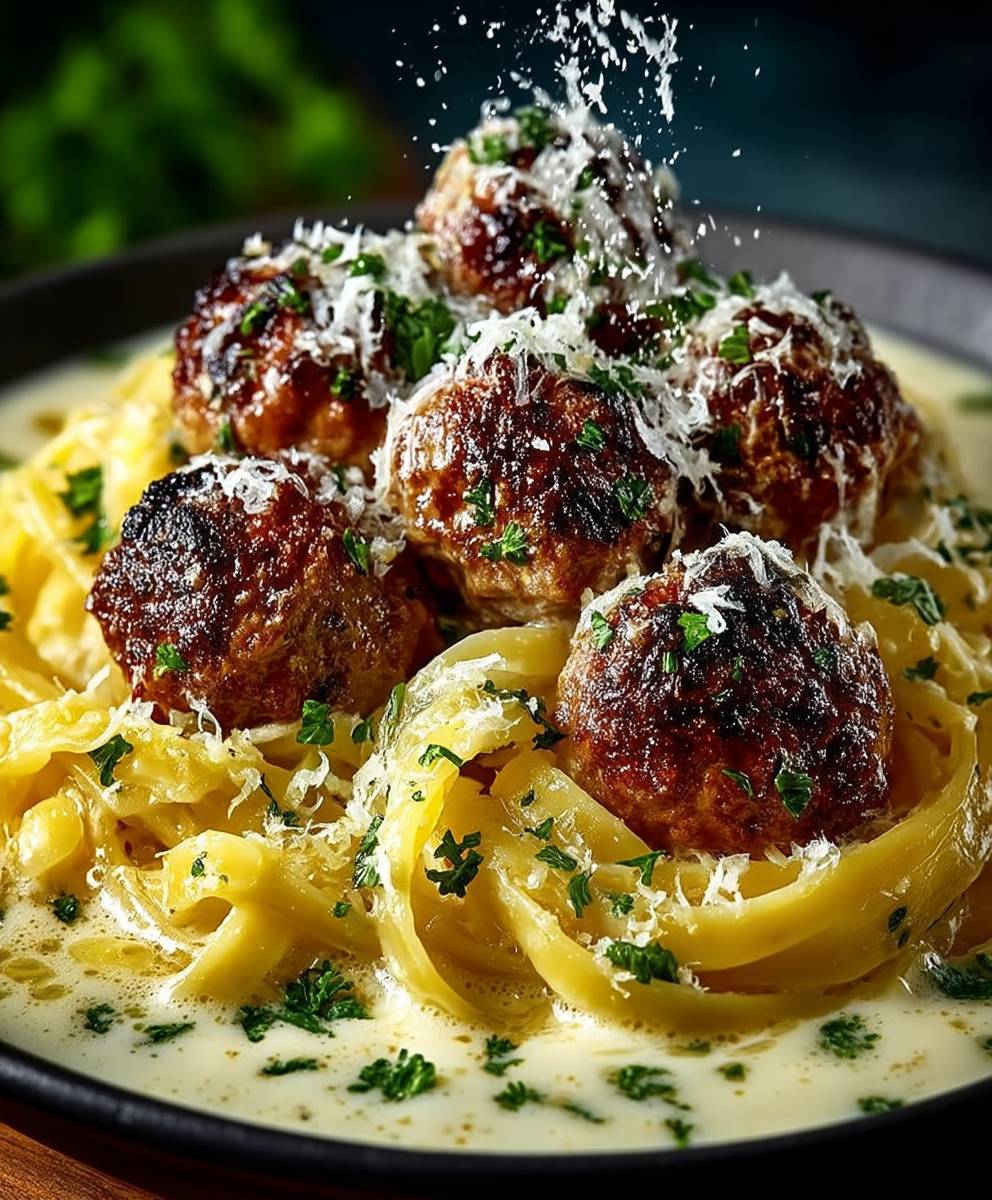Coconut Curry Ramen: Prepare to embark on a culinary adventure that will tantalize your taste buds and leave you craving more! Imagine the comforting warmth of ramen noodles swimming in a rich, creamy coconut curry broth, infused with aromatic spices and vibrant vegetables. This isn’t just another bowl of noodles; it’s an experience.
While ramen’s origins trace back to China, it has become a beloved staple in Japanese cuisine and has since captured hearts (and stomachs!) worldwide. The beauty of ramen lies in its versatility, allowing for endless variations and flavor combinations. Our Coconut Curry Ramen recipe takes this adaptability to a whole new level, blending the best of Southeast Asian flavors with the comforting familiarity of ramen.
What makes this dish so irresistible? It’s the perfect harmony of textures and tastes. The tender ramen noodles provide a satisfying chew, while the creamy coconut milk creates a luxurious base for the fragrant curry spices. The addition of fresh vegetables adds a delightful crunch and a burst of freshness. People adore this dish because it’s quick, easy to customize, and delivers an explosion of flavor in every single bite. Whether you’re a seasoned ramen enthusiast or a curious foodie looking for a new culinary thrill, this recipe is guaranteed to become a new favorite.
Ingredients:
- For the Broth:
- 4 cups vegetable broth (low sodium preferred)
- 1 can (13.5 oz) full-fat coconut milk
- 2 tablespoons red curry paste (adjust to taste for spiciness)
- 1 tablespoon soy sauce (or tamari for gluten-free)
- 1 tablespoon lime juice, freshly squeezed
- 1 teaspoon grated ginger
- 2 cloves garlic, minced
- 1 teaspoon brown sugar (or maple syrup)
- 1/2 teaspoon turmeric powder
- 1/4 teaspoon red pepper flakes (optional, for extra heat)
- Salt and pepper to taste
- For the Noodles and Toppings:
- 8 oz ramen noodles (fresh or dried)
- 1 cup sliced mushrooms (shiitake, cremini, or button)
- 1 cup chopped bok choy (or spinach)
- 1/2 cup edamame (shelled)
- 1/4 cup chopped green onions
- 1/4 cup chopped cilantro
- 1 lime, cut into wedges (for serving)
- Optional toppings: toasted sesame seeds, sriracha, fried tofu, soft-boiled egg
Preparing the Coconut Curry Broth
- Sauté the Aromatics: In a large pot or Dutch oven, heat a tablespoon of oil (coconut or vegetable oil works well) over medium heat. Add the minced garlic and grated ginger and sauté for about 1-2 minutes, until fragrant. Be careful not to burn the garlic. This step is crucial for building the flavor base of the broth.
- Bloom the Curry Paste: Add the red curry paste to the pot and sauté for another minute, stirring constantly. This process, called “blooming,” helps to release the aromatic oils in the curry paste and intensifies its flavor. You’ll notice the paste becoming more fragrant and vibrant in color.
- Add the Liquids: Pour in the vegetable broth and coconut milk. Stir well to combine everything, ensuring the curry paste is fully dissolved. The coconut milk will add a creamy richness to the broth, while the vegetable broth provides a savory foundation.
- Season the Broth: Add the soy sauce, lime juice, brown sugar, turmeric powder, and red pepper flakes (if using). Stir well to combine. The soy sauce adds umami, the lime juice provides acidity, the brown sugar balances the flavors, the turmeric adds color and earthy notes, and the red pepper flakes provide a touch of heat.
- Simmer the Broth: Bring the broth to a gentle simmer over medium-low heat. Cover the pot and let it simmer for at least 15 minutes, or up to 30 minutes, to allow the flavors to meld together. The longer it simmers, the more flavorful the broth will become. Taste and adjust the seasoning with salt and pepper as needed. Remember, you can always add more, but you can’t take it away!
Cooking the Noodles and Vegetables
- Cook the Ramen Noodles: While the broth is simmering, cook the ramen noodles according to the package directions. Fresh ramen noodles typically cook in just a few minutes, while dried noodles may take a bit longer. Be careful not to overcook the noodles, as they will become mushy. Drain the noodles well and set aside.
- Sauté the Mushrooms: In a separate skillet, heat a tablespoon of oil over medium-high heat. Add the sliced mushrooms and sauté for about 5-7 minutes, until they are browned and softened. Season with a pinch of salt and pepper. Sautéing the mushrooms separately allows them to develop a richer, more savory flavor.
- Add the Vegetables to the Broth: Once the broth has simmered for the desired amount of time, add the chopped bok choy and edamame to the pot. Cook for about 2-3 minutes, until the bok choy is wilted and the edamame is heated through. You want the bok choy to retain some of its crispness.
Assembling the Coconut Curry Ramen
- Divide the Noodles: Divide the cooked ramen noodles evenly among bowls.
- Ladle the Broth: Ladle the hot coconut curry broth over the noodles in each bowl, ensuring that each bowl gets a generous amount of broth and vegetables.
- Add the Toppings: Top each bowl of ramen with the sautéed mushrooms, chopped green onions, and chopped cilantro.
- Garnish and Serve: Garnish with lime wedges and any other desired toppings, such as toasted sesame seeds, sriracha, fried tofu, or a soft-boiled egg. Serve immediately and enjoy!
Tips and Variations:
- Spice Level: Adjust the amount of red curry paste and red pepper flakes to your liking. If you prefer a milder flavor, start with a smaller amount of curry paste and omit the red pepper flakes.
- Protein: Add your favorite protein to the ramen, such as grilled chicken, shrimp, tofu, or tempeh.
- Vegetables: Feel free to substitute or add other vegetables, such as carrots, bell peppers, or broccoli.
- Broth Consistency: If you prefer a thicker broth, you can add a cornstarch slurry (1 tablespoon cornstarch mixed with 2 tablespoons cold water) to the simmering broth.
- Make it Vegan: Ensure that your vegetable broth and curry paste are vegan-friendly.
- Leftovers: Leftovers can be stored in the refrigerator for up to 3 days. The noodles may absorb some of the broth, so you may need to add a little extra broth when reheating.
Detailed Ingredient Notes:
- Vegetable Broth: Using a high-quality vegetable broth is key to a flavorful ramen. Low-sodium broth allows you to control the saltiness of the final dish. You can also use homemade vegetable broth if you have it on hand.
- Coconut Milk: Full-fat coconut milk is recommended for the creamiest and richest flavor. Light coconut milk can be used, but the broth will be less creamy.
- Red Curry Paste: Red curry paste is a blend of chilies, lemongrass, galangal, and other spices. The quality and spiciness of curry pastes can vary, so taste and adjust accordingly.
- Ramen Noodles: Fresh ramen noodles are ideal, but dried ramen noodles work well too. Look for ramen noodles that are specifically designed for ramen soup.
- Mushrooms: Shiitake mushrooms add a particularly umami flavor to the ramen, but cremini or button mushrooms are also good options.
- Bok Choy: Bok choy is a type of Chinese cabbage that adds a slightly sweet and peppery flavor to the ramen. Spinach can be used as a substitute.
- Edamame: Edamame adds a pop of color and protein to the ramen.
- Lime Juice: Freshly squeezed lime juice is essential for adding brightness and acidity to the broth.
- Ginger and Garlic: Fresh ginger and garlic are key aromatics that add depth of flavor to the broth.
- Brown Sugar: A touch of brown sugar balances the flavors of the broth and adds a hint of sweetness. Maple syrup can be used as a substitute.
- Turmeric Powder: Turmeric powder adds color and earthy notes to the broth.
- Soy Sauce: Soy sauce adds umami and saltiness to the broth. Tamari can be used as a gluten-free alternative.
Conclusion:
This Coconut Curry Ramen isn’t just another noodle dish; it’s a flavor explosion waiting to happen in your kitchen! I truly believe this recipe is a must-try because it perfectly balances creamy coconut milk, fragrant curry spices, and the satisfying slurp of ramen noodles. It’s quick enough for a weeknight dinner but impressive enough to serve to guests. The beauty of this recipe lies in its versatility and the sheer depth of flavor you can achieve in under 30 minutes.
Think of it: the richness of the coconut milk mingling with the warmth of ginger and garlic, all infused with the vibrant notes of your favorite curry powder. Then, you have the perfectly cooked ramen noodles, soaking up all that deliciousness. It’s a symphony of textures and tastes that will leave you craving more.
But the fun doesn’t stop there! This recipe is incredibly adaptable. Feel free to experiment with different vegetables. Sliced bell peppers, baby spinach, or even some roasted broccoli would be fantastic additions. If you’re feeling adventurous, try adding a protein like grilled shrimp, tofu, or shredded chicken. For a spicier kick, add a pinch of red pepper flakes or a drizzle of sriracha.
Serving Suggestions and Variations:
* Garnish with Fresh Herbs: A sprinkle of fresh cilantro, Thai basil, or green onions adds a burst of freshness and visual appeal.
* Add a Soft-Boiled Egg: A perfectly runny egg adds richness and creaminess to the broth.
* Make it Vegan: Use vegetable broth and tofu for a completely plant-based meal.
* Spice it Up: Add a chili garlic sauce or a few drops of your favorite hot sauce for an extra kick.
* Get Creative with Toppings: Consider adding toasted sesame seeds, crushed peanuts, or crispy fried onions for added texture and flavor.
* Make it a Meal Prep Staple: This ramen is great for meal prepping! Just store the noodles separately from the broth to prevent them from getting soggy.
I’ve poured my heart into perfecting this recipe, and I’m so excited for you to try it. I truly believe that once you experience the magic of this Coconut Curry Ramen, it will become a regular in your meal rotation. It’s a comforting, flavorful, and satisfying dish that’s perfect for any occasion.
So, what are you waiting for? Gather your ingredients, put on some music, and get cooking! I’m confident that you’ll love this recipe as much as I do. And most importantly, don’t be afraid to experiment and make it your own. Cooking should be fun and creative, so let your imagination run wild!
Once you’ve tried it, I’d absolutely love to hear about your experience. Did you make any modifications? What were your favorite toppings? Share your photos and stories in the comments below! Your feedback is invaluable, and it helps me continue to create and share recipes that you’ll love. Happy cooking, and I can’t wait to see what you create! Let me know if you have any questions, and I’ll do my best to help. Enjoy!
Coconut Curry Ramen: A Delicious and Easy Recipe
Creamy and flavorful Coconut Curry Ramen with tender noodles, vibrant vegetables, and a customizable spice level. A comforting and satisfying meal!
Ingredients
- 4 cups vegetable broth (low sodium preferred)
- 1 can (13.5 oz) full-fat coconut milk
- 2 tablespoons red curry paste (adjust to taste for spiciness)
- 1 tablespoon soy sauce (or tamari for gluten-free)
- 1 tablespoon lime juice, freshly squeezed
- 1 teaspoon grated ginger
- 2 cloves garlic, minced
- 1 teaspoon brown sugar (or maple syrup)
- 1/2 teaspoon turmeric powder
- 1/4 teaspoon red pepper flakes (optional, for extra heat)
- Salt and pepper to taste
- 8 oz ramen noodles (fresh or dried)
- 1 cup sliced mushrooms (shiitake, cremini, or button)
- 1 cup chopped bok choy (or spinach)
- 1/2 cup edamame (shelled)
- 1/4 cup chopped green onions
- 1/4 cup chopped cilantro
- 1 lime, cut into wedges (for serving)
- Optional toppings: toasted sesame seeds, sriracha, fried tofu, soft-boiled egg
Instructions
- In a large pot or Dutch oven, heat a tablespoon of oil (coconut or vegetable oil works well) over medium heat. Add the minced garlic and grated ginger and sauté for about 1-2 minutes, until fragrant. Be careful not to burn the garlic.
- Add the red curry paste to the pot and sauté for another minute, stirring constantly.
- Pour in the vegetable broth and coconut milk. Stir well to combine everything, ensuring the curry paste is fully dissolved.
- Add the soy sauce, lime juice, brown sugar, turmeric powder, and red pepper flakes (if using). Stir well to combine.
- Bring the broth to a gentle simmer over medium-low heat. Cover the pot and let it simmer for at least 15 minutes, or up to 30 minutes, to allow the flavors to meld together. Taste and adjust the seasoning with salt and pepper as needed.
- While the broth is simmering, cook the ramen noodles according to the package directions. Drain the noodles well and set aside.
- In a separate skillet, heat a tablespoon of oil over medium-high heat. Add the sliced mushrooms and sauté for about 5-7 minutes, until they are browned and softened. Season with a pinch of salt and pepper.
- Once the broth has simmered for the desired amount of time, add the chopped bok choy and edamame to the pot. Cook for about 2-3 minutes, until the bok choy is wilted and the edamame is heated through.
- Divide the cooked ramen noodles evenly among bowls.
- Ladle the hot coconut curry broth over the noodles in each bowl, ensuring that each bowl gets a generous amount of broth and vegetables.
- Top each bowl of ramen with the sautéed mushrooms, chopped green onions, and chopped cilantro.
- Garnish with lime wedges and any other desired toppings, such as toasted sesame seeds, sriracha, fried tofu, or a soft-boiled egg. Serve immediately and enjoy!
Notes
- Spice Level: Adjust the amount of red curry paste and red pepper flakes to your liking. If you prefer a milder flavor, start with a smaller amount of curry paste and omit the red pepper flakes.
- Protein: Add your favorite protein to the ramen, such as grilled chicken, shrimp, tofu, or tempeh.
- Vegetables: Feel free to substitute or add other vegetables, such as carrots, bell peppers, or broccoli.
- Broth Consistency: If you prefer a thicker broth, you can add a cornstarch slurry (1 tablespoon cornstarch mixed with 2 tablespoons cold water) to the simmering broth.
- Make it Vegan: Ensure that your vegetable broth and curry paste are vegan-friendly.
- Leftovers: Leftovers can be stored in the refrigerator for up to 3 days. The noodles may absorb some of the broth, so you may need to add a little extra broth when reheating.





